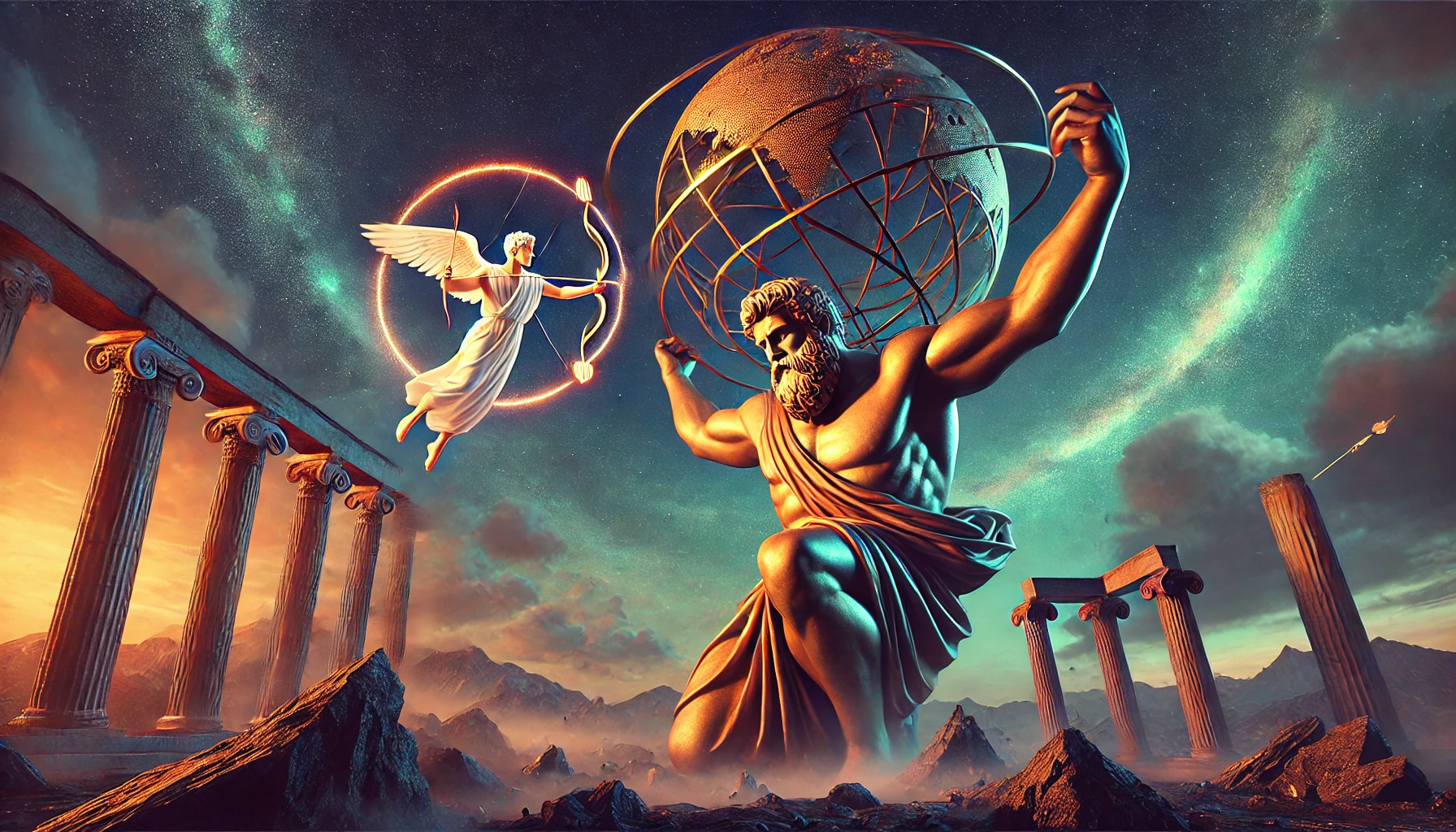Lifestyle
Exploring Unexpected Pre-Scene Passion: The Story of Atlas and Eros

Introduction
Overview of the concept “unexpected pre-scene passion
The phrase “unexpected pre-scene passion” describes the emotional intensity or deep connection that happens before a significant event or moment. It can refer to the build-up of emotions, anticipation, or a hidden spark that later shapes a story or situation. This concept is often seen in mythology, art, and literature. It adds depth and meaning to the narratives, making them more engaging for audiences.
Introduction to Atlas and Eros in mythology
Atlas and Eros are well-known figures in Greek mythology, each representing unique ideas.
- Atlas: He is a Titan famous for holding up the sky. His story symbolizes strength, responsibility, and the burden of carrying a heavy load.
- Eros: He is the god of love and desire, often linked to passion, attraction, and the power of emotional bonds.
Both figures have strong symbolic meanings. When we think about Atlas and Eros together, it brings up the idea of balancing duty and passion, or how burden and love can intersect in unexpected ways.
Purpose and scope of the article
This article explores the concept of “unexpected pre-scene passion” through the lens of Atlas and Eros. It will explain their roles in mythology, their symbolism, and how their stories connect. By looking at their interplay, readers will understand how ancient myths still relate to modern ideas of love, responsibility, and emotional intensity. This guide will provide insights into this unique concept while using the keyword “unexpected pre-scene passion: atlas eros” naturally throughout the content.
Understanding ‘Unexpected Pre-Scene Passion
Definition and context of the term
The term “unexpected pre-scene passion” refers to the emotional intensity or spark that occurs before a significant moment or event. It’s an unanticipated connection or feeling that sets the stage for what’s to come. This passion might not be obvious at first, but it often drives the events that follow. It is about emotions building up before they fully unfold in action or dialogue.
This concept appears in many forms of storytelling, from ancient myths to modern tales. It adds a layer of depth to the narrative, making it more engaging and relatable.
Examples in literature and art
The idea of “unexpected pre-scene passion” has been explored in various ways throughout history:
- Literature: In Shakespeare’s Romeo and Juliet, the intense feelings between the characters before they openly declare their love can be seen as unexpected pre-scene passion. Their initial connection sets the tone for their tragic yet passionate story.
- Art: Renaissance paintings often capture moments of emotional intensity before major events. For instance, in depictions of Atlas, artists show his strength and burden with a hint of passion in his expression, symbolizing the emotional weight of his duty.
- Mythology: In Greek myths, the story of Eros shooting his arrows to create love often highlights unexpected passion. His actions spark emotions that lead to dramatic consequences, such as the story of Psyche and Cupid.
Significance in storytelling
“Unexpected pre-scene passion” is a powerful tool in storytelling. It creates anticipation and emotional depth, drawing the audience into the story. It helps:
- Build Tension: This passion sets the stage for major events, making the outcome more impactful.
- Develop Characters: It reveals hidden layers of characters, showing their vulnerabilities and desires.
- Engage the Audience: It keeps readers or viewers invested by making them feel the intensity of the moment.
In the context of “unexpected pre-scene passion: atlas eros,” this idea captures the connection between duty and desire, strength and vulnerability. It bridges the gap between mythology and modern themes, showing how ancient stories still resonate today.
Mythological Background of Atlas
Role of Atlas in Greek Mythology
Atlas is one of the Titans in Greek mythology, known for his immense strength and enduring punishment. After the Titans were defeated by the Olympian gods, Atlas was condemned to hold up the heavens for eternity. This role represents his unyielding strength and perseverance. Unlike other mythical figures, Atlas does not participate in grand adventures but serves as a reminder of responsibility and enduring hardship.
Symbolism Associated with Atlas
Atlas is a powerful symbol in mythology and culture.
- Strength and Endurance: Atlas embodies physical and mental strength. His story is often used to symbolize carrying heavy responsibilities.
- Burden of Leadership: He represents the challenges of bearing great responsibilities, whether for oneself or others.
- Connection to the Earth and Sky: By holding up the heavens, Atlas is seen as a bridge between the earthly and the divine.
Atlas’s name is also linked to maps and geography. The term “atlas” for a collection of maps originates from his image holding the world.
Atlas’s Burden and Its Interpretations
The image of Atlas carrying the sky has inspired various interpretations:
- Punishment and Sacrifice: Atlas’s burden is seen as a punishment, symbolizing the consequences of rebellion or defiance.
- Responsibility and Duty: His eternal task is viewed as a metaphor for the weight of responsibility and the need for resilience.
- Strength Through Suffering: Some see Atlas as a figure of inspiration, showing that even under the heaviest burdens, strength and perseverance prevail.
In modern storytelling, Atlas is often used as a metaphor for those who carry emotional or physical burdens, making his story timeless and relatable.
In the context of “unexpected pre-scene passion: atlas eros,” Atlas’s role highlights the tension between duty and desire, strength and vulnerability. His story sets the stage for understanding how responsibility can intersect with passion and emotion.
Mythological Background of Eros
Role of Eros in Greek Mythology
Eros is the Greek god of love, desire, and attraction. He is often depicted as a youthful figure with a bow and arrow, capable of igniting love and passion in anyone he strikes. In early Greek myths, Eros was considered a primordial deity, representing the driving force of creation and the spark of life. Later myths portray him as the playful son of Aphrodite, the goddess of love and beauty.
Eros’s role in mythology often revolves around creating unplanned or intense emotional connections between gods, mortals, or both. His actions frequently lead to unexpected events, showing how love and desire can shape fate.
Symbolism Associated with Eros
Eros is a powerful symbol in both mythology and culture:
- Love and Passion: Eros embodies the intense emotions of romantic and physical love.
- Desire and Longing: He represents the yearning that brings people together.
- Unpredictability of Love: His arrows symbolize the sudden and uncontrollable nature of passion, often striking without warning.
Eros’s image has become an enduring representation of love, often influencing art, literature, and modern romantic traditions.
Eros’s Influence on Love and Passion
Eros plays a significant role in shaping relationships and emotions in Greek myths:
- Divine Relationships: Eros’s interventions often lead to dramatic stories, such as the love between Psyche and himself, where love must overcome trials and obstacles.
- Human Connections: By striking mortals with his arrows, Eros shows how passion can change lives, inspire action, or even lead to conflict.
- The Dual Nature of Love: Eros’s actions highlight how love can be both a blessing and a challenge, bringing joy but also struggles.
In the context of “unexpected pre-scene passion: atlas eros,” Eros represents the powerful emotions that arise unexpectedly, often before major events. His influence shows how passion and love can intersect with other themes like duty, responsibility, and personal struggle, adding depth and complexity to the narrative.
Interplay Between Atlas and Eros
Contrasting Symbols: Burden vs. Passion
Atlas and Eros represent two contrasting yet deeply interconnected symbols in Greek mythology:
- Atlas: A symbol of burden, responsibility, and enduring strength. He carries the weight of the heavens, a metaphor for the challenges and obligations life imposes.
- Eros: A symbol of passion, desire, and the unpredictable nature of love. His arrows ignite emotions that often lead to dramatic and unforeseen consequences.
Together, they highlight the tension between the weight of responsibility and the freedom of passion. This interplay reflects the human struggle to balance duty with emotional desires.
Narrative Intersections in Myths
While Atlas and Eros are not directly linked in Greek mythology, their stories intersect metaphorically in themes of endurance and emotional vulnerability:
- Love Amidst Burden: The weight carried by Atlas can be seen as symbolic of the burdens individuals bear in relationships. Eros, on the other hand, represents the passion that can lighten these burdens or make them more complex.
- Transformative Power of Emotion: Eros’s influence in myths often leads to profound changes, just as Atlas’s eternal burden reshapes his character and symbolizes resilience.
In storytelling, the interaction of these themes creates compelling narratives about strength, vulnerability, and how passion can either alleviate or intensify life’s challenges.
Interpretations of Their Relationship
The symbolic relationship between Atlas and Eros can be interpreted in different ways:
- Balancing Passion and Duty: Atlas represents responsibility, while Eros symbolizes the emotional connections that give life meaning. Together, they suggest that love and duty are not opposing forces but parts of a whole.
- Love as a Burden and Relief: Eros’s arrows can both ease the weight Atlas carries by introducing joy and complicate his burden by adding emotional depth.
- Strength Through Connection: Eros’s passion can inspire resilience in Atlas, showing that even the strongest figures need emotional connections to endure their struggles.
The interplay between Atlas and Eros resonates with modern audiences, as it mirrors the complexities of balancing responsibilities with emotional fulfillment. Their combined symbolism provides a rich framework for understanding “unexpected pre-scene passion” and its role in mythological and contemporary storytelling.
Contemporary Interpretations
Modern Literature and Art Depicting Atlas and Eros
The symbolic interplay of Atlas and Eros continues to inspire modern creators:
- Literature: Writers often use Atlas as a metaphor for responsibility and burden, while Eros represents love and passion. Novels, poetry, and essays explore how these themes intersect in human lives, such as finding love while managing life’s challenges.
- Art: Artists depict Atlas and Eros together in imaginative ways, showing Atlas’s strength contrasted with Eros’s emotional intensity. Paintings, sculptures, and digital art blend their symbols to explore the balance between strength and vulnerability.
- Film and Theater: Stories about characters who carry immense burdens yet experience moments of unexpected passion often draw from the essence of Atlas and Eros, making these ancient symbols relatable to modern audiences.
Psychological Perspectives on Burden and Passion
From a psychological viewpoint, Atlas and Eros reflect two fundamental aspects of the human experience:
- Atlas as the Burden Bearer: The “Atlas complex” is a term used to describe individuals who feel the need to carry the weight of the world on their shoulders. These people often struggle to balance responsibility with personal happiness.
- Eros as Emotional Connection: Eros symbolizes the human need for connection and passion, which can bring joy but also emotional challenges. Love and desire often create inner conflicts, especially when paired with heavy responsibilities.
Understanding these dynamics can help individuals navigate the complexities of balancing duty with emotional fulfillment in their own lives.
Relevance in Today’s Cultural Context
Atlas and Eros remain deeply relevant in modern culture, as they mirror common struggles and aspirations:
- Work-Life Balance: Many people today relate to the weight Atlas carries, managing careers, family, and personal ambitions. Eros’s passion reminds us of the importance of love and connection amid these burdens.
- Emotional Vulnerability in a Strong Exterior: In a world that values strength and resilience, Eros highlights the power of vulnerability and emotional depth.
- Artistic Expression: The themes of burden and passion are frequently explored in modern storytelling, music, and visual media, resonating with audiences who face similar challenges in their own lives.
By reinterpreting Atlas and Eros through contemporary lenses, their ancient stories gain new meaning. These symbols continue to inspire individuals to find strength in love, balance responsibilities, and embrace the complexities of human emotions.
Case Study: ‘Atlas Eros’ in Modern Media
Analysis of Specific Works Featuring Atlas and Eros
Modern media often draws inspiration from the symbolic elements of Atlas and Eros, using them to explore themes of burden, passion, and emotional conflict. Some notable examples include:
- Films: Movies like The Fountain and Atlas Shrugged incorporate themes of enduring responsibility and the transformative power of love. While not explicitly referencing Atlas and Eros, their essence is present in the storytelling.
- Literature: Contemporary novels explore protagonists who, like Atlas, shoulder immense burdens yet find moments of unexpected passion that reshape their lives. Stories often depict this through relationships, personal growth, and the tension between duty and desire.
- Visual Art: Artists have reimagined Atlas and Eros in modern contexts, blending the imagery of strength and vulnerability. Digital and conceptual art often juxtaposes the figure of Atlas holding the heavens with the ethereal presence of Eros, symbolizing love as a liberating force.
Themes of Unexpected Passion in These Works
The portrayal of Atlas and Eros in modern media often focuses on the theme of “unexpected pre-scene passion.” Key themes include:
- Love as a Disruptive Force: Eros’s influence often appears as a sudden and powerful connection that disrupts the structured life of an “Atlas-like” character.
- Balancing Emotion and Responsibility: Many stories highlight the tension between carrying life’s burdens and allowing oneself to experience passion and love.
- Transformation Through Vulnerability: The interplay of Atlas and Eros often leads to personal transformation, showing how emotional openness can create growth and change.
These themes resonate deeply with audiences because they reflect universal human experiences.
Audience Reception and Critique
Audiences often connect with the symbolic representation of Atlas and Eros because these archetypes mirror real-life struggles.
- Positive Reception: Viewers and readers frequently praise works that capture the emotional complexity of balancing love and responsibility. The raw portrayal of vulnerability, paired with themes of strength, creates stories that feel relatable and inspiring.
- Critique: Some critiques focus on the oversimplification of these themes in certain media, where the complexity of Atlas’s burden or Eros’s passion may be underexplored. When done well, however, these symbols create a profound emotional impact.
Modern interpretations of “Atlas Eros” allow creators to explore timeless ideas in innovative ways. By weaving themes of unexpected passion and enduring responsibility into their works, they craft narratives that continue to captivate and inspire audiences across cultures and generations.
Conclusion
The stories of Atlas and Eros represent two powerful and contrasting forces: the unyielding burden of responsibility and the unpredictable intensity of passion. Throughout mythology and modern interpretations, their symbolism has provided a rich framework for exploring human struggles and emotions. Atlas embodies strength, perseverance, and duty, while Eros personifies love, vulnerability, and connection. Together, they reflect the balance we all seek between fulfilling obligations and embracing our emotional desires.
The enduring legacy of Atlas and Eros lies in their timeless relevance. Their narratives continue to inspire art, literature, and psychological discussions, reminding us of the complexities of human experience. The concept of “unexpected pre-scene passion” encapsulates the spark of emotion that precedes significant events, adding depth and meaning to both ancient myths and contemporary storytelling. By understanding the interplay between burden and passion, we gain insight into our own lives, finding strength in vulnerability and purpose in love. These enduring symbols remain a testament to the human condition, offering lessons that transcend time.
Thank you for visiting our blog! If you enjoyed this post, feel free to check out more interesting and helpful content here

-

 Law & Personal Injury6 days ago
Law & Personal Injury6 days agoHow to File a Sample Complaint for Sanctions Against an Attorney in Illinois
-

 Fashion1 week ago
Fashion1 week agoWhat are the Differences Between Microlocs vs Sisterlocks?
-

 Entertainment1 week ago
Entertainment1 week agoAura of Vitality 5e: A Complete Guide to Healing and Support in Combat
-

 Entertainment6 days ago
Entertainment6 days agoKamryan Randolph Wrestling: The Journey of a Rising Star in Sports















